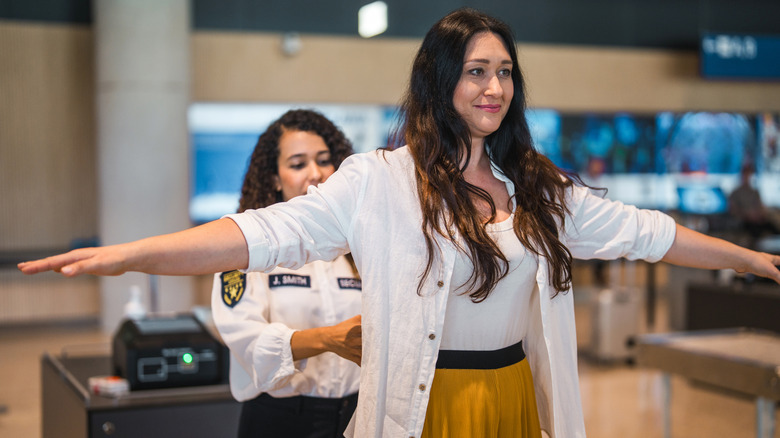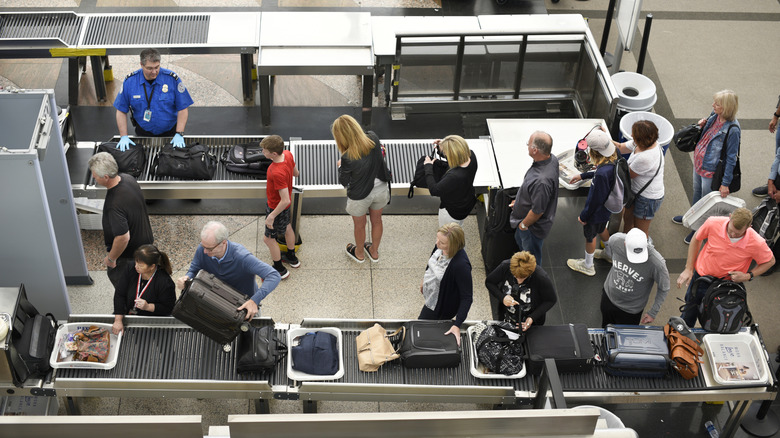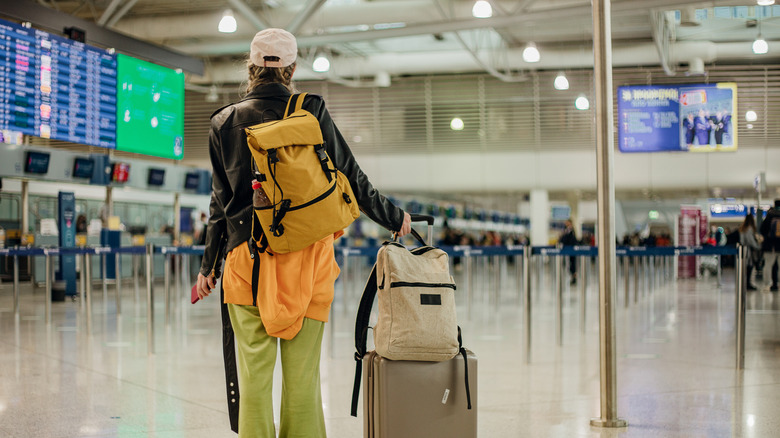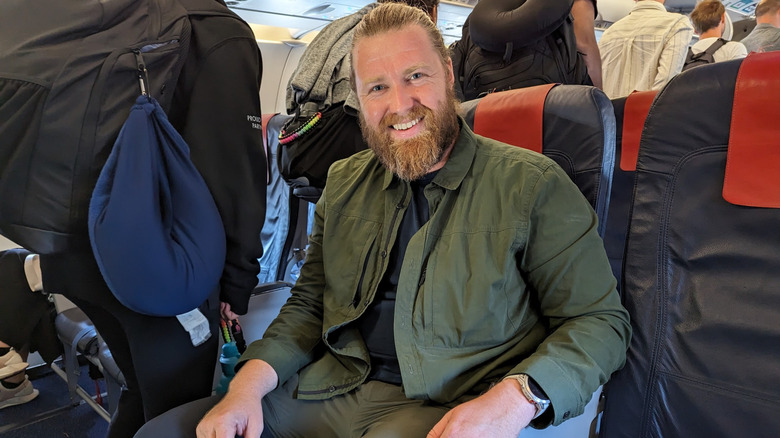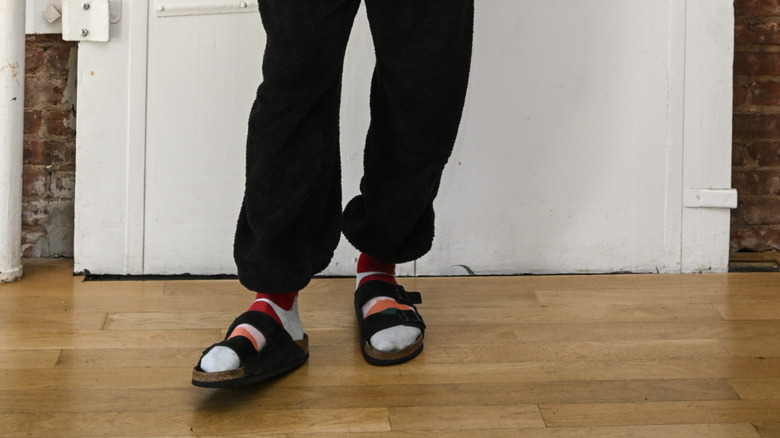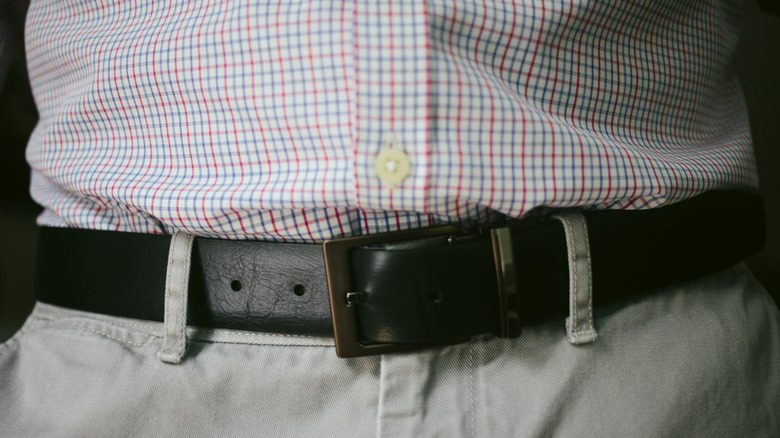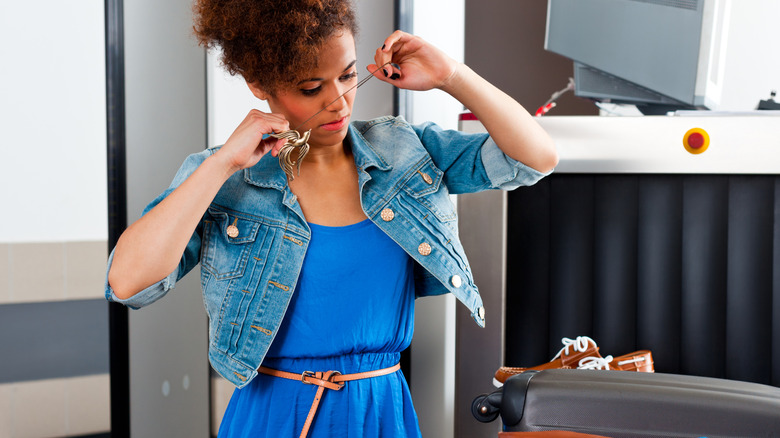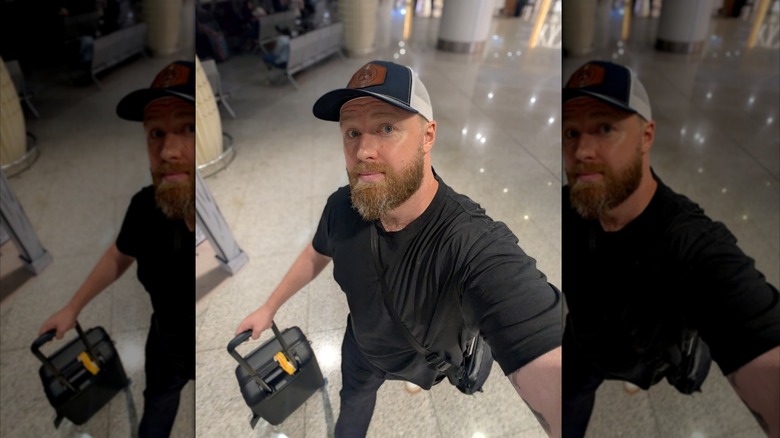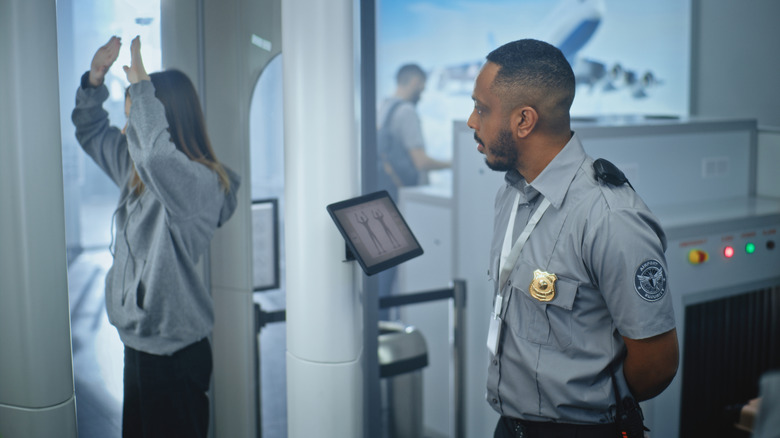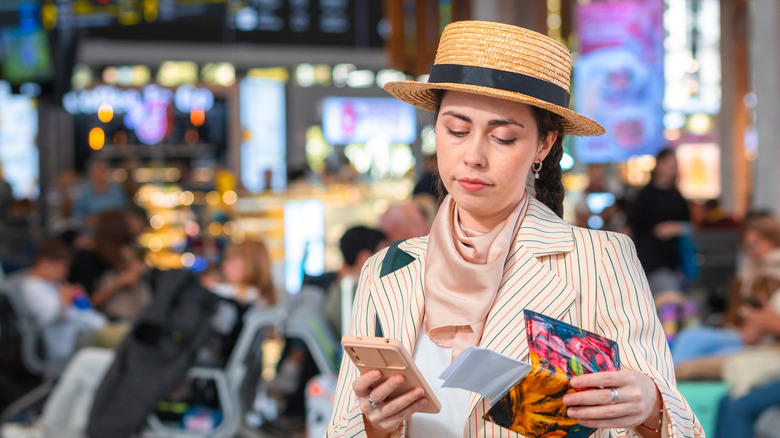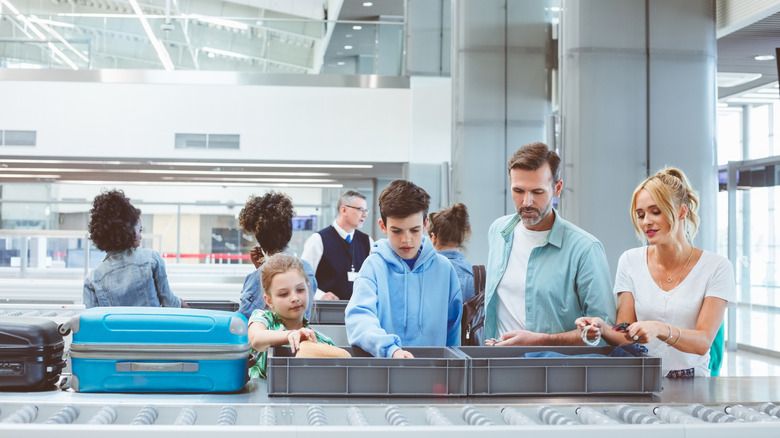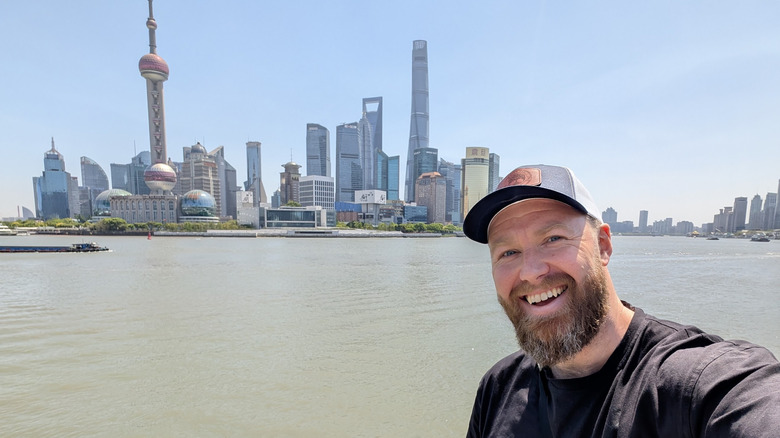How To Dress To Minimize Security Hassles At The Airport
Airports, for all of their flaws, are wonderful places. They're hopeful, buzzing hubs, where adventure begins and ends. They're heartbreaking stages, where families are reunited or separated. And yes, I know they're overpriced, but they're also home to the greatest beer experience on the planet: the pre-takeoff morning beer.
But all that anticipatory fervor can be dulled in the blink of an eye. And you know exactly where it happens: the security line. We've all been there — panicked unpacking and undressing at the conveyor belt, running back to throw your watch in the tray, looking suspiciously out of breath and being pulled aside for a frisk, before emptying the contents of your perfectly packed luggage on the counter while they search for your nail clippers. It's a nightmare. It flusters you. And it can put a damper on your day.
As someone who's traveled full-time for six years, I've learned my lessons the hard way. As a prolific sweater, staying calm is imperative for me. A 16-hour flight with a damp T-shirt is not the way I want to start an adventure, so I've built a foolproof dressing and packing system that lets me breeze through security with minimal hassle. From what I wear to specific purchases that transformed my travel days, here's how to minimize security hassles at the airport.
Why it matters
While most of my decisions are purely self-involved, dressing and packing effectively help almost everyone around you. To put things in perspective, if every one of the 876 million passengers passing through U.S. airports each year shaved just one second off their security processing, the TSA could gain back over 30,000 workdays. Obviously, that's a bit of a mad statistic, but the theory adds up — the more prepared we are as passengers, the more efficient the whole process is.
On top of the broader implications, dressing effectively can save you hassle. Security staff are paying far more attention to clothing than you'd expect. From the shape and texture to the number of pockets, some stuff is more likely to get you pulled over for a personalized experience than others. And then, lastly, it feels great to breeze through with no issues. The world feels brighter, you feel like a pro, and you can spend the rest of your airport time without any stress.
The golden rule
I hate to break it to you. No one really cares how good you look at the airport. They do care about how much you've slowed the line by taking your jewelry, thick boots, and puffer jacket off, and they definitely resent how long you've spent arguing about whether paste is a liquid or a solid (spoiler: it's a liquid).
No, the golden rule, which should be obeyed above all else listed here, is to dress for efficiency and not style. Luckily, in today's age, you can usually do both. But when making any decisions, opt for the one that will save you time and stress at the airport. Technology is improving, too, and within a few years it'll be tremendously easy to waltz through security wearing whatever you fancy, but for now it's still too inconsistent.
The mentality
When packing and dressing before the airport, I always hone in on my intent. This sounds stupid and over-the-top, but planning for the security line instead of the destination makes my airport days far easier. As mentioned earlier, my sweating adds extra pressure to the situation, but tweaking my approach to cater to security has helped tremendously.
So what does it mean to pack and dress for the airport and not the destination? For me, that means analyzing what's in my carry-on luggage. Is there anything in there that could be questionable enough for a secondary check? Is there anything little like toothpaste I could grab airside? For liquids, I learned the best way to pack them leak-free in my checked luggage. Is there a big piece of clothing that I've avoided putting in my checked luggage to keep my weight low that is going to ruin my morning in a hot airport?
For dressing, it means I'm adaptable. I'm warm enough in a cold airport and cool enough in a warm one. I'm not drawing the attention of a security officer with tons of pockets and bulky clothes. And anything I take off can be done so quickly, then put back on equally swiftly at the other end. In my experience, planning for a cold or warm destination isn't worth it. If you can't cope with the taxi ride or train journey to your hotel, just open your checked luggage before you leave the airport and change.
Shoes: The dealbreaker
Let's start at the bottom and work our way up. Shoes can make or break your time in security. The U.S. has been well behind the rest of the world regarding security checks for a while now, and although the TSA recently announced it'll be relaxing the mandatory shoes-off rule in airports, it'll take a while to implement fully. Most other countries don't require travelers to remove shoes, but some types will draw attention no matter what you do.
In my early backpacking days, I used to wear boots everywhere. They were lightweight, but the thicker soles were an immediate red flag to agents all over the world. Smugglers have been known to put drugs in the soles, while scarier situations, like the one that prompted the U.S's strict stance, saw bombs in them, too.
Nowadays, I wear one of two pairs. For airports where I'll need to do a bit of walking or traveling to get to, I have comfortable tennis shoes, which I keep loosely tied so I can slip them on and off with no problems. If I know the airport or it's a simple taxi job there, I wear my Birkenstock slides with a clean pair of thick athletic socks — heavy emphasis on the clean part. Both of these options are lightweight, don't draw attention, and allow you to throw them on and off without even bending over. Those are my preferences, but any easy slides are good. Flight attendants think the most comfortable shoes to wear in the airport are slip-ons or laceless, too. I'm not a fan of bare feet on planes, though.
Jackets, hoodies, and layers
You can't go through the body scanners with big jackets on. Sometimes, you'll scrape through with a light hoodie, but generally speaking, you'll always get told to take them off. With that in mind, why bother wearing them? I understand some of these might be pretty big, and if you're flying carry-on only, you don't have a choice, but wherever possible, try to pack them in your checked bag.
With that said, I had two outer layers that I would regularly throw on at the airport, but for very different reasons than staying warm or cold. They actually helped me with security by giving me extra room to throw small items that I had on me. One item, shown in the photo above, is my go-to travel shirt. It's only slightly heavier than a normal button-up, but it has two massive yet hidden slip-in chest pockets. Each pocket is big enough for a passport to slide in with a boarding pass unfolded. I wear this almost every single flight without fail.
When approaching the security line, I'd throw my passport, ring, wallet, watch, and earphones into the pockets. Once I arrived at the conveyor belt, I'd take the shirt off, throw it in the tray, and pick it up on the other side. No scrambling to grab my items, no need for an extra bag, and it was enough of a layer to keep me warm, too. I'd breeze through and not even put my valuables back on until I was sitting at the gate. Or pub. Later, I used a denim jacket for the same purpose. Not as practical, but useful in colder airports and on long flights
Belts and buckles
I haven't worn a belt while traveling for years. I only owned one while we were on the move anyway, and I always opted to keep it in my checked luggage on travel days. They're a nuisance and clumsy to take on and off. Plus, they're easily forgotten when heading through the scanners, and uncomfortable while you're sitting on a plane for hours. Why would I bring one?
Instead, find some trousers that fit you properly. Even better, grab a pair with an elastic waist. They're far more comfortable, have one less thing to remove during screening, and expand to match your greediness in the departure area restaurants. My go-to pair is actually hiking pants. They're super comfortable on a plane, slightly thicker so they keep my legs warm, have an elasticated waist, and actually don't look half as bad as it sounds.
Some women might opt to wear a skirt instead of pants. I'm a guy, so I can't speak on tons of female tips, but apparently, a tight skirt is one unexpected piece of clothing you should avoid wearing through a TSA screening. Many women have reported uncomfortable experiences because of the pat-downs triggered by the possibility of concealed items.
Jewelry and accessories
Jewelry and accessories can be an absolute nightmare on travel days. I'm not much of a jewelry person, but I do have a ring and a watch that come with me pretty much anywhere I go. As my list is minimal, they don't impact my day too much. Some people, however, stroll through security with bracelets, necklaces, earphones, chargers, rings, watches, gadgets, gizmos, and everything in between. That's too much.
Not only are you making it more likely that you'll lose something, you're slowing yourself down and increasing the chances of lighting up the scanner like it's Christmas. A few things are okay — a watch is handy, your earphones are important for the flight, and even a little bit of jewelry works, but dial it back a bit. And for the stuff you do bring, read the next section. You need your laptop, but tourists should avoid putting it deep inside their carry-on. Instead, grab a laptop bag or luggage with a sleeve.
Bags
I was never a bag person in the airport. For years, I had my carry-on backpack (which was too big and made me warm), and stuffed everything else into my pockets or the bag itself. I prided myself on the lack of a roller suitcase and was reluctant to change anything.
That was until last year, when I discovered the power of an expandable sling. As we approached our final year of travel, I bought this fantastic little sling bag. When full, it carried my phone, my passport, my wallet, my over-ear headphones, a book, and my Nintendo Switch. There was even a little space left to force my ring and watch in there during security, too (Although this TSA agent thinks rings are the one thing you should never take off at airport security).
Having this bag allowed me to keep my essentials with me at all times. I never had to unpack my carry-on case, and the security tray stayed neat and tidy. Literally, all I need to do is grab the bag on the other side, and I'm gone. You can see above how light I travel now. At airports that don't require shoes off, I'm through in seconds, leaving everyone else behind. It even fits comfortably in most seatback pockets on planes, too. If you need to put it on the floor, it barely takes up any space whatsoever. It's borderline perfect.
Cultural/global differences
This isn't technically advice on how to dress or pack, but it should inform how you do those things. Unsurprisingly, each country and even airport has its own rules and quirks to get your head around. The U.S. is widely seen as one of the strictest for air travel — something that threw a foreigner like me off. Other countries are strangely relaxed with their rules, while others may have the rules in place but lack the staff who feel the need to implement them.
Before you start getting ready, check out the rules for the airports you'll be flying through. Do they have the new bag scanners that mean you can leave laptops and electronics inside? Do they have an old, beat-up system that needs everything laid out? Are they especially strict about plastic bags for liquids? Is it a super busy airport? Or is it like Salt Lake City International Airport, which has the quickest TSA times in the country? All of these things can have an impact on how your day goes. Plan accordingly.
Hats, scarves, and headwear
I only started wearing hats in the past year, and so far they haven't been an issue. Sure, it's one more thing to throw in the tray, but it's super fast to take off and put back on, so the impact is negligible. However, I have seen people stopped after the body scanner for not removing them.
While you can technically wear hats (some airports make you take them off for the scan), it's easier just to take them off and throw them in your tray. You're far less likely to be stopped. People with long hair, like I once was, might find this annoying, so consider it when putting together your outfit for the day.
Of course, if the headgear is religious or cultural, keep it on and let the agent know. You may still get pulled aside if the alarm goes off, but keeping agents informed will at least help things go a little more smoothly.
Kids and family dressing
No, I'm not talking about turning up to the airport in matching outfits — though plenty do. It's one thing to dress yourself for efficiency. It's something else entirely to dress an army of minions to get through security with ease. Kids can be hyper, their attentions can go everywhere, and you might have handed them an iPad to keep them occupied as they go. That could spell chaos for you.
In general, keep kids on the same routine as you. This means simple, comfortable clothes with minimal take-offs and put-ons, nothing in their pockets, and definitely no electronics in their hands. Dealing with all this before you get in the security line is key. It'll make life far less stressful for you and them. Luckily, kids under 12 can keep their jackets and shoes on, but it still pays to keep everything else simple.
You're already a legend for traveling with kids. Everyone else will think so when they see your whole family breezing through security like it's the typical school run.
My exact routine
My exact routine is what makes my airport days so easy now. I'll typically check the airport and country-specific rules the night before in case there's anything unusual. Assuming there's nothing I need to adapt for, I get packing. If I'm flying with checked luggage, I'll push its capacity to the limit. I want my carry-on to be as light as possible, and only contain things I can't afford to lose, but a quick change of clothes. In my case, that'll mean my laptop, my camera, and a charger for them, plus spare underwear, a t-shirt, some pants, and some socks. That's it, if I can help it. The laptop goes into the front sleeve of my carry-on for easy access. I've got no liquids if I can help it. I grab any toiletries for a quick trip on the other side.
I dress in almost the same outfit every time. My dark blue merino wool T-shirt dries fast, doesn't hold odor, and hides sweat marks if I get anxious. I throw my green travel shirt over the top with my passport in the breast pocket for easy access. I have my elasticated waist hiking pants on, along with my Birkenstock-and-sock combo. I'll typically wear a snapback cap now for a little extra comfort on the plane. My sling bag holds my phone, wallet, headphones, book, Nintendo Switch, headphone adapter, and a couple of charging cords.
At the airport, once I'm in security, I'm already taking off my watch and ring and slipping them into my sling along with my passport. My hat is off, clipping the snapback around the sling strap. Once I've stopped moving, the laptop is slid out of the case, and my travel shirt comes off. I'll have checked ahead to make sure shoes don't need to come off. By the time I step up to the tray, I just need to put my shirt and sling in one, and my carry-on in the other. I leave the camera inside the carry-on because I'm rarely asked to take it out. On the other side, I grab my shirt and bags, and I'm gone, not stopping to put my hat, ring, or watch back on until I get to where I'm sitting — usually in the airport bar.
Methodology
Everything in this piece is informed by six years of trial and error in airports across the world. In that time, I've visited more than 50 countries, taken hundreds of flights, and experienced the best and worst airports on the planet. I've never breezed through airports the way I do now, and this article outlines the tips and tricks that make it possible.
